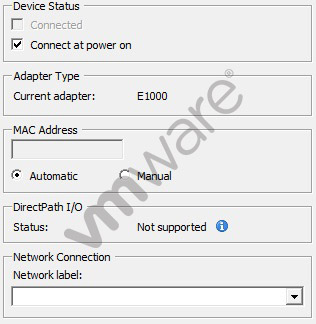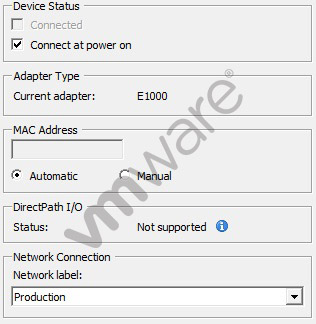VMware Certified Professional on vSphere 5 v7.4
Question 1
A vSphere administrator has been using vSphere in evaluation mode and now wants to deploy an environment that provides the same features.
Which edition of vSphere provides similar functionality to evaluation mode?
- A. Enterprise Plus
- B. Enterprise
- C. Standard
- D. Essentials
Answer : A
Question 2
Which installation method is not available for a new deployment of ESXi 5.x?
- A. Update Manager installation
- B. Text-based interactive installation
- C. Scripted installation
- D. Auto Deploy installation
Answer : A
Question 3
How should a vSphere administrator disable memory compression?
- A. Attach a vSphere Client to an ESXi host and edit the Mem.MemZipEnable advanced setting.
- B. Connect to vCenter Server using the vSphere Client and edit the virtual machine. Insert the Mem.MemZipDisable option and set the value to True.
- C. Connect a vSphere Client to vCenter Server and configure the Memory Compression setting from the Administration menu.
- D. Reboot the ESXi host and disable memory compression in the BIOS under Advanced Settings.
Answer : A
Question 4
Which Single Sign-On deployment mode should an administrator use for two 5.x vCenter
Servers configured with linked mode?
- A. Basic Single Sign-On with vCenter Server Heartbeat
- B. Multisite Single Sign-On
- C. Basic Single Sign-On
- D. Single Sign-On with Linked Mode
Answer : B
Explanation: http://pubs.vmware.com/vsphere-
55/index.jsp?topic=%2Fcom.vmware.vsphere.install.doc%2FGUID-C6F362AF-397C-4271-
A9A1-4EEF1C718AA9.html -
Question 5
Which Web service is installed during the vCenter Server installation?
- A. Internet Information Service (IIS)
- B. WEBrick
- C. Tomcat Web server
- D. LiteSpeed Web server
Answer : C
Question 6
An administrator attempts to install vCenter Single Sign-On Server. The installer returns an error message indicating that the installation failed. Prior to the installation, all setup prerequisites were met. The administrator has generated a vCenter Server Single Sign-On support bundle.
Which two files should the administrator analyze to determine the cause of the failure?
(Choose two.)
- A. Server\utils\logs\imsTrace.log
- B. Server\utils\logs\install.txt
- C. %TEMP%\utils\logs\vminst.log
- D. %TEMP%\vminst.log
Answer : A,D
Explanation:
http://kb.vmware.com/selfservice/microsites/search.do?language=en_US&cmd=displayKC
&externalId=2033880
https://www.vmware.com/support/ws5/doc/intro_techsup_ws.html
Topic 2, Plan and Configure vSphere Networking
Question 7
The Edit Settings wizard reports a virtual machine is configured as follows:
-- Exhibit --

-- Exhibit --
Which setting, if NOT configured, will prevent network connectivity?
- A. The network label must be supplied.
- B. The MAC address must be supplied.
- C. The device status must be set to Connected.
- D. The DirectPath I/O status must be Supported.
Answer : A
Question 8
An administrator is deploying vSphere 5.5. The administrator creates a vSphere Distributed
Switch, then uses Auto Deploy to deploy several ESXi hosts. After the hosts are deployed, the administrator notices that LACP packets are not being sent between them.
Which condition would cause this issue to occur?
- A. The LACP support settings do not exist in the Host Profile.
- B. The LACP installation bundle is not included in the Image Profile.
- C. The LACP setting is not enabled on vCenter Server.
- D. LACP has not been configured on the Auto Deploy server.
Answer : A
Question 9
An application administrator reports application slowness when loading the application's web portal. The virtual machine is currently connected to a vSphere Distributed Switch. The application owner requests information about the virtual machine's network traffic.
Which feature of a vSphere Distributed Switch should the administrator use to gather the needed information?
- A. NetFlow
- B. Port Mirroring
- C. Network I/O Control
- D. Promiscuous Mode
Answer : A
Question 10
A vSphere administrator creates a new vSphere Distributed Switch. The administrator receives notice from the service desk that a cluster of vSphere hosts has disconnected from vCenter Server. This disconnect occurred immediately after the new switch was created.
This vSphere Distributed Switch is the only distributed switch managed by vCenter.
The virtual machines are still functional and the applications are still accessible by end users.
On the ESXi hosts, which step must the vSphere administrator take to allow vCenter
Server to reconnect?
- A. Use the Direct Console User Interface to reattach the management vmnic to the appropriate switch
- B. Use the Direct Console User Interface to disable lockdown mode on each affected host
- C. Use the ESXi Shell to restart the mgmt-vmware service on each affected host
- D. Use the ESXi Shell to restart the vSphere Web Client service on each affected host
Answer : A
Question 11
A security team is validating policy settings in a vSphere environment.
By default, which security policy is set to reject on a vSphere Standard Switch?
- A. Promiscuous mode
- B. MAC address changes
- C. Forged transmit
- D. Use explicit failover
Answer : A
Question 12
An administrator needs to deploy a vSphere solution containing a number of hosts and a vSphere Distributed Switch.
Which steps should the administrator take to accomplish this?
- A. Create the vSphere Distributed Switch, deploy the ESXi hosts, and then add each host to the switch.
- B. Deploy the ESXi hosts, create an HA/DRS cluster containing the hosts, create the vSphere Distributed Switch, and then add the cluster to the switch.
- C. Create the vSphere Distributed Switch and as each ESXi host is deployed it will be automatically added to the switch.
- D. Deploy the ESXi hosts and then create the vSphere Distributed Switch on the hosts.
Answer : A
Question 13
A vSphere administrator has created a vSphere Standard Switch with one virtual machine port group and one physical uplink. The administrator needs to ensure that the virtual machines on this port group can communicate only with each other.
What should the administrator do?
- A. Remove the physical uplink from the vSphere Standard Switch
- B. Create a Private VLAN and apply it to the virtual machine port group on the vSphere Standard Switch
- C. Enable Port Security on the vSphere Standard Switch
- D. Enable the Fenced setting on the virtual machine port group
Answer : A
Question 14
-- Exhibit --

-- Exhibit --
An administrator is unable to configure Receive Side Scaling on the vmnic driver in a
Windows 2008 R2 guest.
Based on the exhibit, what would need to be modified to enable this option?
- A. Manually configure a static MAC address
- B. Enable DirectPath I/O
- C. Ensure the vmnic is attached to the correct network
- D. Change the adapter type to VMXNET3
Answer : D
Question 15
An administrator is building a new vSphere Standard Switch with two active uplinks. The physical switch ports for these uplinks are placed in an etherchannel.
Which load balancing policy should the administrator use to support the etherchannel configuration?
- A. Route based on IP hash
- B. Route based on the originating virtual port
- C. Route based on source MAC hash
- D. Route based on physical NIC load
Answer : A